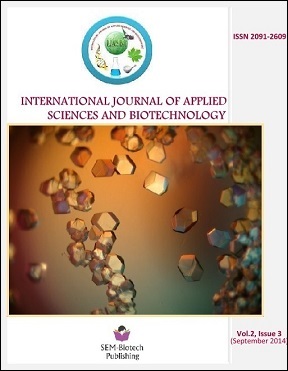Tillage, Residue, Fertilizer and Weed Management on Phenology and Yield of Spring Maize in Terai, Nepal
DOI:
https://doi.org/10.3126/ijasbt.v2i3.11001Keywords:
Maize, tillage, residue, fertilizer, yield, phenologyAbstract
With the aim of developing crop management technologies that reduce the yield gap of maize (Zea mays L.) in Nepal, a study was carried-out to determine whether the grain yield of maize could be manipulated through tillage, residue, and nutrient and weed management practices. The effect of tillage (conventional and no tillage), residue (residue retained and residue removed), fertilizer (recommended doses of fertilizer and farmers’ doses of fertilizer) and weed management practices (herbicide use and manual weeding) on phenology and grain yield of maize were investigated under maize-rice cropping system in Rampur, Nepal during 2013. The experimental results revealed that no tillage had significant effect on grain yield (6.64 Mg ha-1) and phenological parameters like days to silking, physiological maturity and seed fill duration. Similarly, residue retained treatment had significant effect on grain yield (7.02 Mg ha-1) and phenological parameters. Research dose of fertilizer had significant effect on phenological parameters and grain yield (8.42 Mg ha-1). However, weed management factor did not influence significantly on grain yield and phenological parameters. The grain yield increased in no tillage by 23.19% over conventional tillage, residue retained by 39.84% over residue removed, recommended doses of fertilizer by 132.60% over farmer dose of fertilizer. Thus, no tillage, residue retention, recommended doses of fertilizer and use of herbicide for weed management can be alternative technologies for sustainable higher grain yield.
DOI: http://dx.doi.org/10.3126/ijasbt.v2i3.11001
Int J Appl Sci Biotechnol, Vol. 2(3): 328-335




